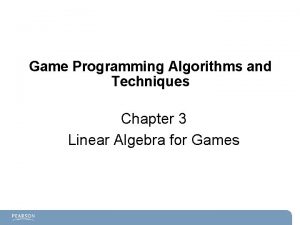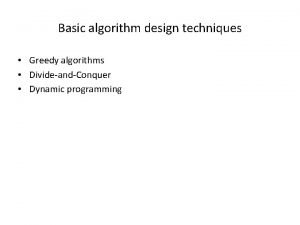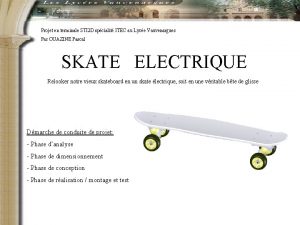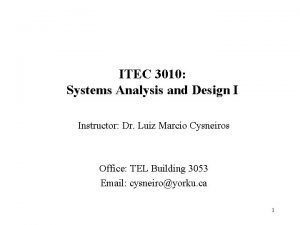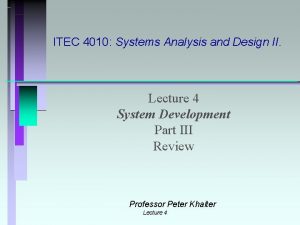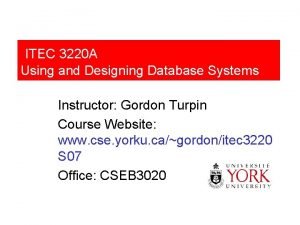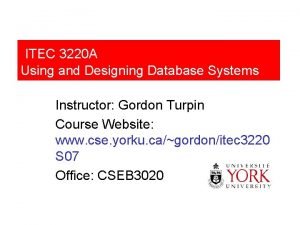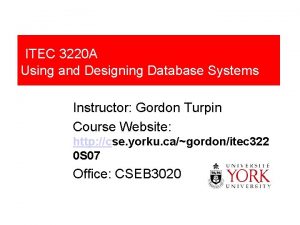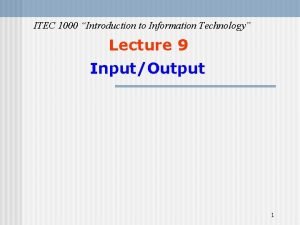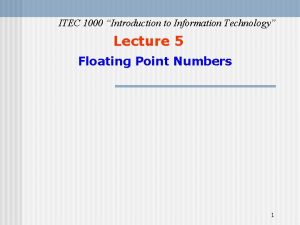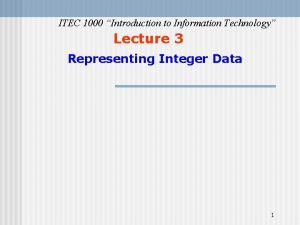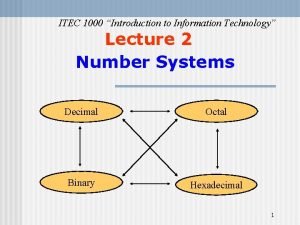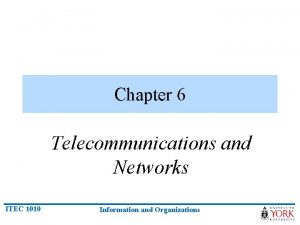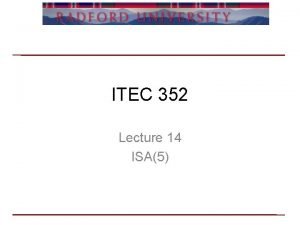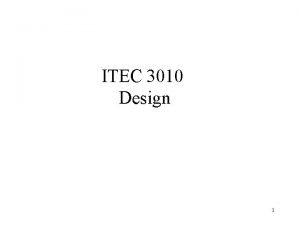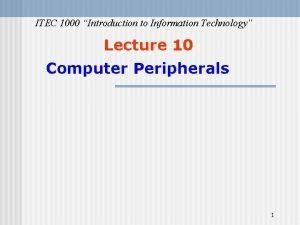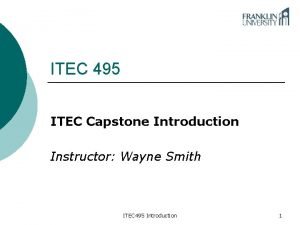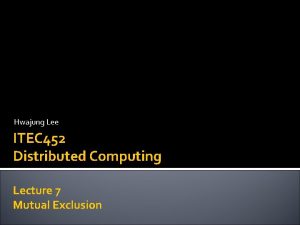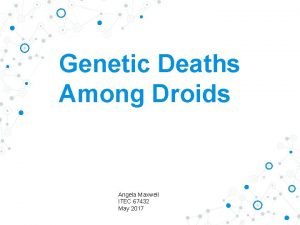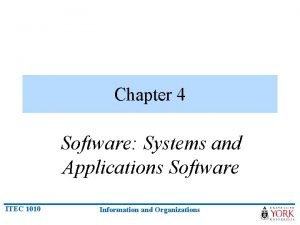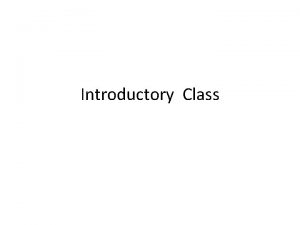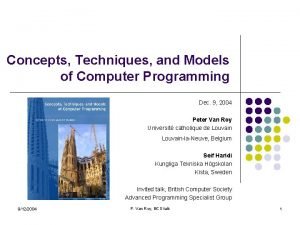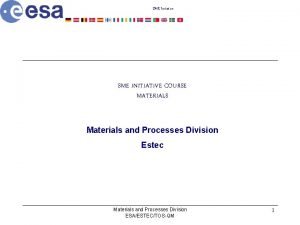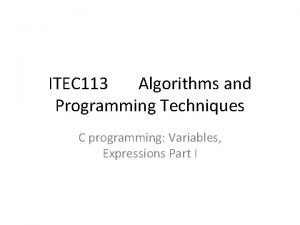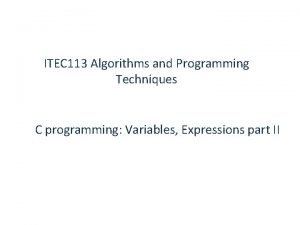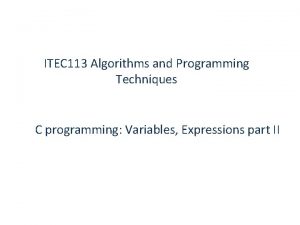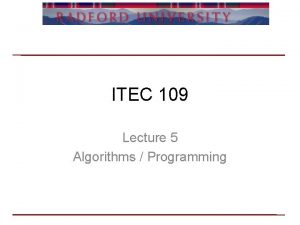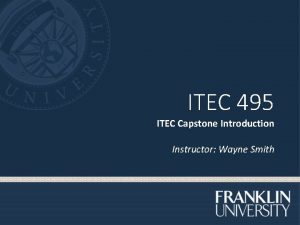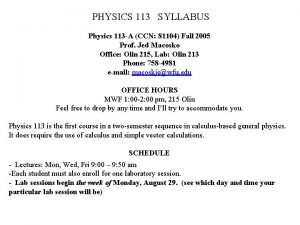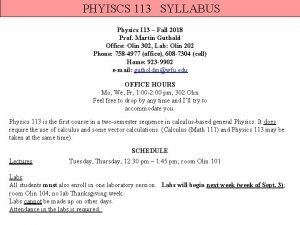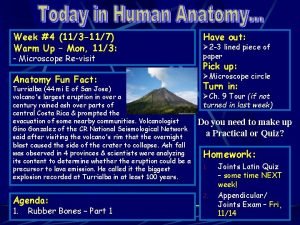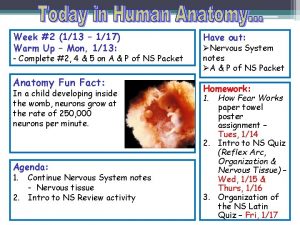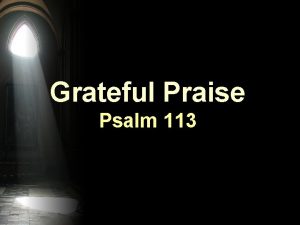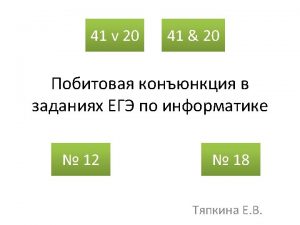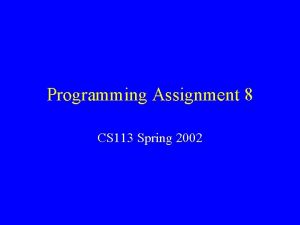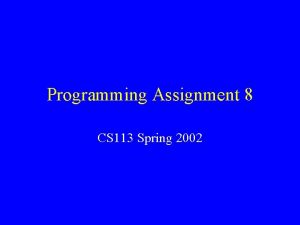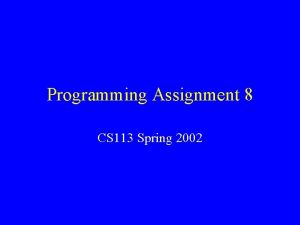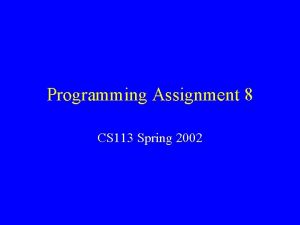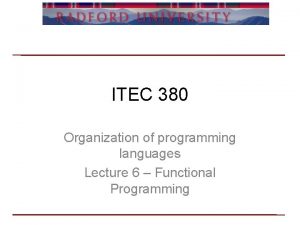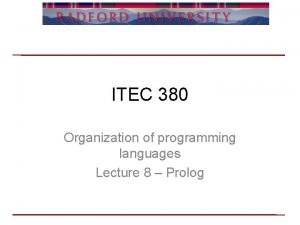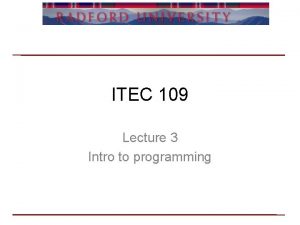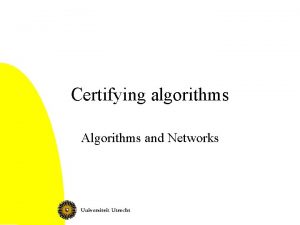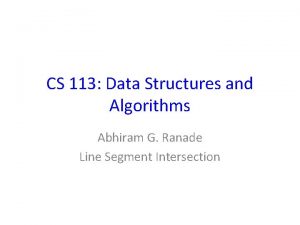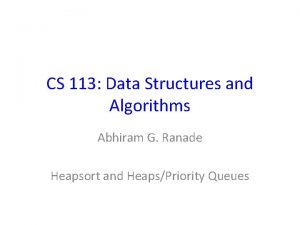ITEC 113 Algorithms and Programming Techniques Lecture 2













































- Slides: 45

ITEC 113 Algorithms and Programming Techniques Lecture 2 : Selection Statements

Recap

Definition of algorithm • A procedure for solving a mathematical problem in a finite number of steps that frequently involves repetition of an operation • a step-by-step procedure for solving a problem or accomplishing some end especially by a computer Source: http: //www. merriam-webster. com/

So what is an algorithm? • A recipe or a set of step-by-step instructions that describe a solution to a given problem. • In the context of computer programming “well-ordered collection of unambiguous and effectively computable operations, that when executed, produces a result and halts in a finite amount of time. ”

Characteristics of an Algorithm • Well-ordered: the steps are in a clear order • Unambiguous : the operations are understood by the computer module without any further simplification • Effectively computable: the computer module can actually complete the execution of the specified operations in a finite amount of time

Method for Developing an Algorithm • Define the problem : Describe the problem in clear and brief terms • List inputs : Clearly specify information needed for the solution of the problem (can be input from the keyboard, a file etc) • List outputs : Describe the result that the algorithm will produce • Describe the steps needed to accomplish the desired result : How to manipulate/use the inputs to produce the desired output • Test the algorithm : Verify that the algorithm works.

Structured Programming All programs can be written using three control structures Sequence : Selection : Repetition : one statement is executed after another A statement is executed or skipped depending on whether a condition evaluates to TRUE or FALSE. Example: if, switch Statements are executed repeatedly until a condition evaluates to TRUE or FALSE. Example: while, for


Pseudocode • Consists of natural language-like statements that precisely describe the steps of an algorithm or program • Statements describe actions • Focuses on the logic of the algorithm or program • No language-specific elements • Written at a level so that the desired programming code can be generated almost automatically from each statement • Keywords written using upper case letters • (Optional) Steps are numbered. • Subordinate numbers and/or indentation are used for dependent statements in selection and repetition structures • (Optional) Variables and Constants are declared

Pseudo. Code Constructs • • • Assignment: You can use either one of these – Set num 1 to 1 assignment statements. We prefer – Num 1 1 the second one Computation – Use all arithmetic operators: addition (+), subtraction (-). Division (/), multiplication (*), modulus (%) … Input – INPUT : to enter from the keyboard – READ : to read from a file Output – DISPLAY : to display on screen – PRINT : to print on the printer Selection – IF. . END IF – IF. . ELSE …END IF – SWITCH. . CASE … Repetition (Will be covered later)

FLOWCHARTING SHAPES Symbol Name Terminal Input Display Function Indicates the starting or ending of the program Used for data entry from keyboard. Used for displaying on screen Process Indicates any type of internal operation inside the Processor or Memory (STORE INFORMATION & DO CALCULATIONS variables) Decision Used to ask a question that can be answered in a binary format (Yes/No, True/False) Connector Allows the flowchart to be drawn without intersecting lines or without a reverse flow. Predefined Process Used to invoke a subroutine or an interrupt program.

Rules for flowcharting • All boxes of the flowchart are connected with Arrows. (Not lines) • Flowchart symbols have an entry point on the top of the symbol with no other entry points. – Exception : connector symbol circle used in loops! • The exit point for all flowchart symbols is on the bottom. – Exception: The Decision symbol has two exit points; these can be on the sides or the bottom and one side. • Generally a flowchart will flow from top to bottom, and left to right. • Connectors are used to connect breaks in the flowchart. Examples are: – From one page to another page. – From the bottom of the page to the top of the same page. • Subroutines have their own and independent flowcharts. • All flow charts start with a Terminal or Predefined Process symbol. • All flowcharts end with a terminal.

Benefits of Flowcharts • Make communication on the logic of a system easier. • Make analysis of the problem more effective and easier • Serve as a good program documentation, which is needed for various purposes. • Act as a guide or blueprint during the systems analysis and program development phase. • Aid in debugging process. • Make maintenance of programs easier

Sequence Statements • Statements are executed one after the other in the same order as they are written • Default execution! Example : Read a number from keyboard and print its square on screen START num 1 sq num 1*num 1 sq END INPUT num 1 Sq num 1*num 1 DISPLAY sq

Selection Statements • Selection statements: decide whether or not to execute a particular statement • Also called the conditional statements or decision statements IF Statement is a flexible construct where you can use any condition that evaluates to TRUE or FALSE. Branching is determined by the condition. Switch Statement: Branching depends on the values the parameter may take.

Selection Statements: Simple If • Decides whether the statement-block of the if statement will be executed or not. • The statement-block may be a single statement or a group of statements. – If the test expression is true, the statement-block will be executed – otherwise the statement-block will be skipped

Selection Statements: Simple If Example: Prompt the user to enter a number and print “positive” if number is greater than 0. START num 1 FALSE ? Num 1>0 TRUE “Positive” END INPUT num 1 IF num 1>0 DISPLAY “Positive” ENDIF

Selection Statement: If. . else • This is an extension of simple if where one of two branches is selected by the if condition. • If the test expression is true , then the true-block statement(s), immediately following the if statement are executed • otherwise the false-block statement(s) are executed. • Either true-block or false-block will be executed, not both.

Selection Statements: If. . else Example: Prompt the user to enter a number and print “positive” if number is greater than 0, otherwise print “negative”. START num 1 FALSE ? num 1>0 TRUE “Positive” END INPUT num 1 IF num 1>0 DISPLAY “Positive” ELSE DISPLAY “Negative” ENDIF

Part 2 : New Material • Nested Selection statements • Loops

Selection Statements: If. . Elseif ladder • Multipath decisions are represented using IF ELSEIF ladder. • A multipath decision is a chain of IF statements in which the statement associated with each ELSE is an IF. • The conditions are evaluated from the top downwards. • As soon as a TRUE condition is found, the statement associated with it is executed and IF statement exits. • When all the all conditions enumerated as ELSEIF statements become FALSE, the final ELSE containing the default statement will be executed.

Selection Statements: If. . else Example: Prompt the user to enter a number and print “positive” if number is greater than 0, if the number if less than 0 print “negative”, otherwise print “Zero” START num 1 FALSE ? num 1<0 FALSE ? num 1>0 TRUE “Negative” TRUE “Positive” “Zero” END INPUT num 1 IF num 1>0 DISPLAY “Positive” ELSEIF num 1<0 DISPLAY “Negative” ELSE DISPLAY “Zero” ENDIF

Selection Statements: Nested If’s • When a series of decisions are involved, more than one if. . . else statement may be used in nested form. • Nesting can be done in IF, ELSEIF or ELSE parts if the if statement. • It is possible to nest very large number of if statements but readability of the program/algorithm will be reduced!

Selection Statements: If. . else Example: Prompt the user to enter a number and print “positive” if number is greater than 0, if the number if less than 0 print “negative”, otherwise print “Zero” START num 1 FALSE ? num 1>0 TRUE “Positive” FALSE ? num 1>=0 TRUE “Negative” “Zero” END INPUT num 1 IF num 1<0 DISPLAY “Negative” ELSE IF num 1>0 DISPLAY “Positive” ELSE DISPLAY “Zero” ENDIF

Selection Statements: If. . else Example: Prompt the user to enter a number and print “positive” if number is greater than 0, if the number if less than 0 print “negative”, otherwise print “Zero” START num 1 FALSE “Negative” ? num 1>=0 TRUE “Zero” FALSE ? num 1>0 TRUE “Positive” END INPUT num 1 IF num 1>=0 IF num 1>0 DISPLAY “Positive” ELSE DISPLAY “Zero” ENDIF ELSE DISPLAY “Negative” ENDIF

Looping Statements • Loops are used to perform repetitive tasks – such as printing sequential numbers on screen. • The statements enclosed inside a loop are usually executed more than once. • Each execution is called an iteration.


Flowchart Loops A live performance of walking to a chair and sitting on it!

START TAKE ONE PACE FORWARD IS CHAIR IN FRONT OF YOU? YES NO

START TAKE ONE PACE FORWARD IS CHAIR IN FRONT OF YOU? YES NO

START TAKE ONE PACE FORWARD IS CHAIR IN FRONT OF YOU? YES NO

START TAKE ONE PACE FORWARD IS CHAIR IN FRONT OF YOU? NO YES TURN AROUND AND SIT ON IT STOP

WHILE …… ENDWHILE loop : characteristics • Iteration count is greater than and equal to 0 (zero). • If the condition is initially FALSE Loop Body will never be executed. • Working Mechanism : First Check then Execute • The loop is repeated as long as the condition is true!

WHILE …… ENDWHILE loop : structure ? Condition YES Instruction 1 Instruction 2 …. NO WHILE condition Instruction-1 Instruction-2 … ENDWHILE

WHILE …… ENDWHILE loop : example • Display all integer numbers between 1 and 10 on screen. The boundaries (1 and 10) should also be displayed. START i 1 ? i<=10 i 1 WHILE i <= 10 Display i i i +1 ENDWHILE NO YES i i i + 1 END

DO…. . WHILE loop : characteristics • Iteration time is greater than and equal to 1. • Even if the condition is initially FALSE the Loop will be executed at least once. • Working Mechanism is First Execute and Then Check • Iterations are carried out while condition is TRUE, and stopped when the condition is FALSE.

DO…. . WHILE loop : structure DO Instruction-1 Instruction-2 … WHILE condition Instruction 1 Instruction 2 …. YES ? Condition NO

DO…. . WHILE loop : example • Display all integer numbers between 1 and 10 on screen. The boundaries (1 and 10) should also be displayed. START i 1 DO Display i i i+1 WHILE i <= 10 i i i+1 YES ? i<=10 NO END

REPEAT…. . UNTIL loop : characteristics • Iteration time is greater than or equal to 1. • Even if the condition is initially TRUE the Loop will be executed at least once. • Working Mechanism is First Execute and Then Check • Iterations are carried out while condition is FALSE, and stopped when the condition is TRUE.

REPEAT…. . UNTIL loop : structure Instruction 1 Instruction 2 …. NO ? Condition REPEAT Instruction-1 Instruction-2 … UNTIL condition YES

REPEAT…. . UNTIL loop : example • Display all integer numbers between 1 and 10 on screen. The boundaries (1 and 10) should also be displayed. START i 1 i 1 REPEAT i i + 1 Display i UNTIL i > 10 i i i+1 NO ? i>10 YES END

FOR … ENDFOR loop : characteristics • Repeated a "specific" number of times, determined by the program or the user. • "counts" the number of times the body will be executed. • good choice when the number of repetitions is known, or can be supplied by the user.

FOR … ENDFOR loop : structure lowerlimit stepsize NO YES Upper Limit Instruction 1 Instruction 2 …. FOR loopcounter=lowerlimit to upperlimit with increment = stepsize Instruction-1 Instruction-2 … ENDFOR

FOR … ENDFOR loop : example • Display all integer numbers between 1 and 10 on screen. The boundaries (1 and 10) should also be displayed. START i 1 i i+1 ? i <=10 NO YES i i+1 i END i 1 FOR i =1 to 10 with increments = 1 DISPLAY total END FOR

The End
 Dot product rules
Dot product rules Analysis of algorithms lecture notes
Analysis of algorithms lecture notes Introduction to algorithms lecture notes
Introduction to algorithms lecture notes Computational thinking algorithms and programming
Computational thinking algorithms and programming Synchronization algorithms and concurrent programming
Synchronization algorithms and concurrent programming 01:640:244 lecture notes - lecture 15: plat, idah, farad
01:640:244 lecture notes - lecture 15: plat, idah, farad Algorithm design techniques
Algorithm design techniques C programming lecture
C programming lecture Projet itec
Projet itec Ad systems exam slide
Ad systems exam slide Itec 4010
Itec 4010 Itec 3220
Itec 3220 Zona de subduccion
Zona de subduccion Itec 3220
Itec 3220 Itec 3220
Itec 3220 Itec 1000
Itec 1000 Itec 1000
Itec 1000 Itec 1000
Itec 1000 Itec 1000
Itec 1000 Itec 1000
Itec 1000 Itec 1010
Itec 1010 Itec exam results
Itec exam results First cut dcd
First cut dcd Itec 1000
Itec 1000 Itec irrigation controller
Itec irrigation controller Itec 350
Itec 350 Itec
Itec Itec
Itec Cs itec
Cs itec Bectra
Bectra Gestin itec
Gestin itec Gestin itec
Gestin itec Itec 1010
Itec 1010 Phy113
Phy113 Gst 113
Gst 113 Concepts, techniques, and models of computer programming
Concepts, techniques, and models of computer programming Perbedaan linear programming dan integer programming
Perbedaan linear programming dan integer programming Greedy programming vs dynamic programming
Greedy programming vs dynamic programming What is in system programming
What is in system programming Integer programming vs linear programming
Integer programming vs linear programming Definisi linear
Definisi linear Psalm 113:1-4
Psalm 113:1-4 Solithane 113
Solithane 113 Psalm 113:1-4
Psalm 113:1-4 Voice communication army
Voice communication army Perform voice communications army powerpoint
Perform voice communications army powerpoint
